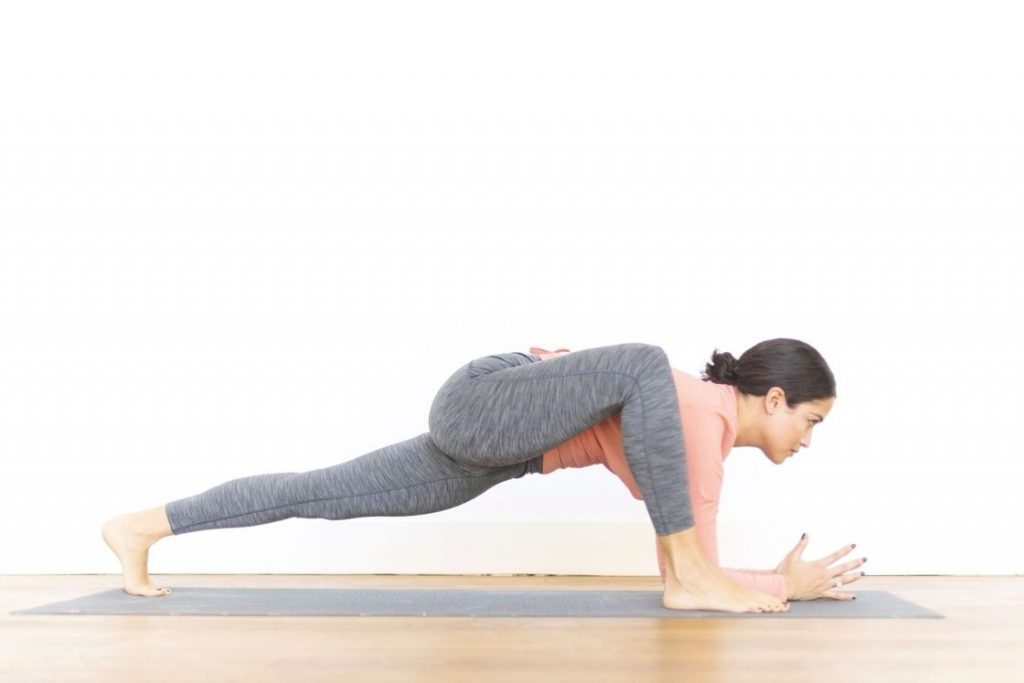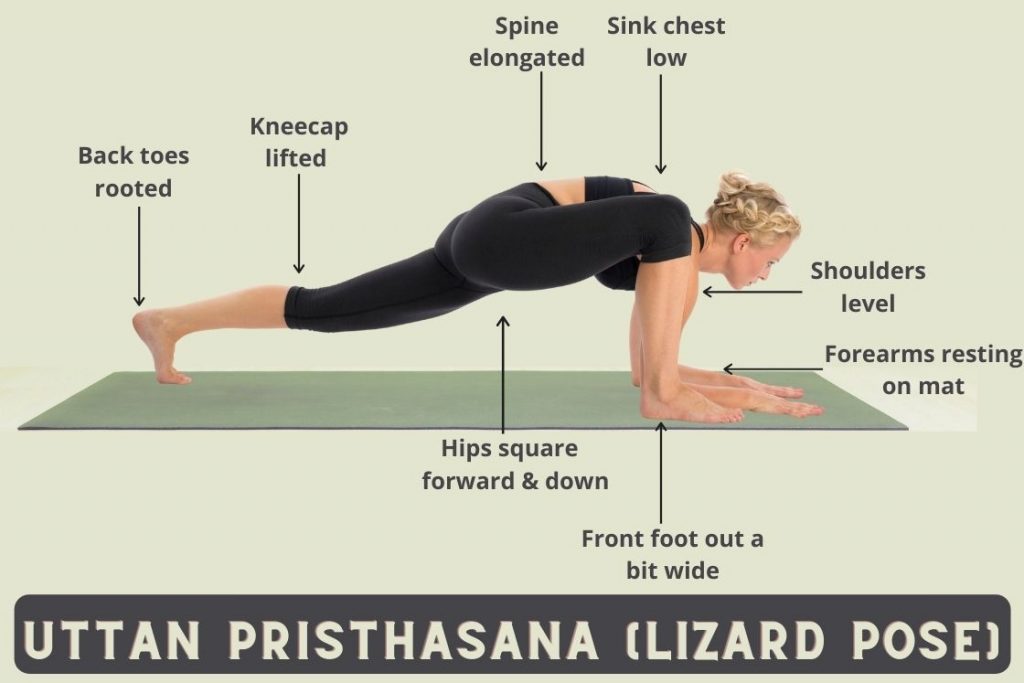
| Sanskrit | Utthan Pristhasana (OOT-tan preesth-AHS-uh-nuh) (उत्तान पृष्ठासन) |
| Meaning | Utthan = Stretching out / Pristha = Back of the body / Asana = Pose |
| Type | Intermediate, hip opener, deep stretch |
| Level | Intermediate |
| Anatomy | Hips, hamstrings, quadriceps, groin, arms, shoulders, spine, core |
| Other Names | Lizard Pose |
Lizard Pose, or Utthan Pristhasana, is an intermediate yoga posture that deeply stretches the hip flexors, hamstrings, and quadriceps. It is known for its intense hip-opening benefits, making it ideal for those looking to increase lower body flexibility and strength. Despite its challenging nature, this pose offers numerous benefits that attract many yoga practitioners.
To enter Lizard Pose, start in Downward-Facing Dog, then step one foot forward outside the corresponding hand and lower your forearms to the floor. The other leg should remain extended with toes firmly pressed into the ground. This position not only opens the hips but also enhances flexibility in the legs, arms, and shoulders while toning the spine, core, and chest muscles.
For beginners who find the full expression of Lizard Pose challenging, there are easier variations that can help build strength and flexibility over time.
Meaning
The term Utthan Pristhasana comes from Sanskrit, where “Utthan” means “stretching out,” “Pristha” means “back of the body,” and “Asana” means “pose.” The name reflects the pose’s focus on stretching and opening the back of the body, particularly the hips and groin.
The English names, Lizard Pose or Gecko Pose, are inspired by the posture’s resemblance to a lizard sprawled on the ground. This position mimics the way a lizard stretches out its body, promoting flexibility and relaxation in the lower body.
Lizard pose practice guide
Lizard Pose (Utthan Pristhasana) requires careful alignment and gradual progression. Begin in Downward-Facing Dog, then step one foot forward and lower your forearms to deepen the stretch. Follow these instructions to achieve the pose safely and effectively.

Preparatory poses
- Lunge Pose (Utthita Ashwa Sanchalanasana)
- Extended Side Angle Pose (Utthita Parsvakonasana)
- Forearm Plank Pose (Phalakasana II)
- Cradle Pose (Hindolasana)
- Bound Angle Forward Bend (Baddha Konasana Uttanasana)
- Half Happy Baby Pose (Ardha Ananda Balasana)
How to do lizard pose(steps)

- Begin in Downward-Facing Dog (Adho Mukha Svanasana).
- Step your right foot forward between your hands, placing it outside the right hand.
- Lower your forearms to the ground, keeping them parallel.
- Use a block for support if needed.
- Extend your left leg straight back, pressing the toes into the ground.
- Press your right knee outward and lower your hips towards the floor.
- Hold the pose for 30 seconds to 1 minute, breathing deeply.
- To release, lift your forearms and step your right foot back to Downward-Facing Dog.
- Repeat on the other side by stepping your left foot forward and following the same steps.
Precautions
- Avoid if you have wrist or shoulder issues; use props for support if needed.Use blocks or a bolster if you have tight hips or find it challenging to lower your forearms.
- Keep your back leg active to prevent lower back strain.
- Place a folded blanket or cushion under your knee if you have knee sensitivity.
- Ease into the pose to avoid overstretching.
- Consult a healthcare provider or experienced yoga teacher if pregnant or if you have specific health conditions
Contraindications
- void if you have an injury in the ankle, knee, hip, or back.
- Do not practice if you are recovering from recent surgery.
- Individuals with abnormal blood pressure should consult a healthcare provider before attempting the pose.
- Skip the pose if you have dislocated shoulders or a hernia.Avoid practicing with a heavy head or severe neck issues.
Follow-up Poses
- Janu sirsasana (Head to knee pose)
- Bound angle pose (Baddha konasana)
- Half lord of the fishes (Ardha matsyendrasana)
Variations
- Utthan pristhasana variation- From prone position cross your arms under your chest. Keep the legs straight and slightly apart. Raise the trunk and bittocks balancing the body on your knees and elbows. Finally, bring your chin and chest to the floor behind the arms.
- Twisted Lizard Pose- This is a bit challenging posture. After attaining the lizard pose, tilt your forward outwards opening the knee to the right. Bend your back knee and reach your left squeezing it towards the buttocks.
- Flying lizard pose- The forearms and front heel are raised from basic the lizard pose. The front leg is then wrapped around the corresponding elbow off the floor. The elbows are bent at 90 degrees, shifting the weight on palms lift the back leg off the floor with toes pointing backward.
- Lizard pose arm variation- With the left heel lifted and toes on the ground bring the left hand to your back. Maintaining the balancing on the front foot and back toes slide the right shoulder under the front knee grabbing the left wrist..
Modifications
- Yoga blocks – If you are finding it difficult to reach the floor while holding the pose, then, place a block under each hand or forearm. This will ease the pose and still maintain the stretch.
- Alternatively, you can place the forward foot on the block. It will increase the stretch on the hips and inner thigh.
- Place a folded towel under your back knee to enter the pose without any discomfort in the knee.
Benefits lizard pose (Utthan Pristhasana)
Lizard Pose (Utthan Pristhasana) enhances hip and hamstring flexibility, strengthens the core and shoulders, and stimulates key energy chakras. It also supports reproductive health, making it a valuable addition to your yoga practice. Incorporate Lizard Pose to improve overall well-being and physical performance.
- Promotes flexibility of chest and hips: Lizard Pose actively stretches the hips and chest, expanding the muscles in these areas. This enhances flexibility in the glutes, hamstrings, and chest, contributing to overall strength and mobility in both the upper and lower body.
- Tones the Abdominal Muscles: In Lizard Pose, the core muscles are actively engaged to maintain balance, which stimulates and strengthens the abdominal muscles. This engagement helps in toning the core and can be beneficial for reducing belly fat.
- Improves Reproductive Health: Lizard Pose positively affects the pelvic region by stretching the groins, which helps reduce stress hormones in this area and enhances blood flow to the reproductive organs. This can promote overall reproductive health. A 2019 study incorporating Utthan Pristhasana showed positive and enhanced results in improving sexual performance.
- Helps in Releasing Toxins: Regular practice of Lizard Pose supports the body’s detoxification system by stimulating internal organs such as the kidneys and liver. This pose promotes hormonal balance and aids in the natural detoxification process.
- Strengthens the Spine and Shoulders: Lizard Pose helps maintain an elongated spine, which supports spinal integrity and provides a deep stretch. The shoulders, which bear the body’s weight during the pose, are strengthened and their endurance is increased.
- Improve body balance: This asana enhances the flexibility of the hamstrings and hip muscles. Additionally, it boosts concentration, which in turn improves overall body balance.
- Stimulates the Energy Chakras: This posture stimulates three key body chakras: Swadhisthana (sacral), Manipura (solar plexus), and Anahata (heart). By engaging the muscles around the torso, navel, and chest, Lizard Pose activates and balances these energy centers.
Conclusion
Lizard Pose (Utthan Pristhasana) is a powerful intermediate yoga posture that offers a range of benefits for both body and mind. It plays a crucial role in enhancing hip flexibility, strengthening the core, and improving overall balance. By incorporating this pose into your routine, you can effectively prepare for more advanced postures and experience significant gains in your practice.
Lizard Pose not only deepens your stretch but also supports a more balanced and robust yoga practice. Embrace the challenges of this pose to elevate your yoga journey and achieve greater physical and mental well-being.
The post Lizard Pose (Utthan Pristhasana): How to Do, Varaitions & Benefits appeared first on Fitsri Yoga.